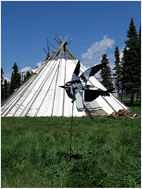Body burdens, sources and interrelations of selected toxic and essential elements among the nine Cree First Nations of Eeyou Istchee, James Bay region of northern Quebec, Canada†
Abstract
Background: this article constitutes a report on the comprehensive Nituuchischaayihtitaau Aschii multi-community environment-and-health study conducted among the Cree peoples (Eeyouch) of northern Quebec, Canada. Objectives: to interpret observed concentrations of a suite of chemical elements in a multi-media biological monitoring study in terms of sources and predictors. Methods: the concentrations of 5 essential and 6 toxic chemical elements were measured in whole blood, and/or in urine or hair by ICP-MS. Concentrations of essential elements are compared to those considered normal (i.e., required for good health) and, when toxic, deemed acceptable at specified concentrations in public health guidelines. Their dependence on age, sex, the specific community lived-in and diet were explored employing multivariate analysis of variance (MANOVA) involving new variables generated by principle component analysis (PCA) and correspondence analysis (CA). Results: the 5 most prominent PCA axes explained 67.7% of the variation, compared to 93.0% by 6 main CA factors. Concentrations of the essential elements in whole blood (WB) and iodine(I) and arsenic (As) in urine were comparable to those reported in the recent Canadian Health Measures survey and are assigned to dietary sources. By contrast, WB cadmium (Cd) was elevated even when smoking was considered. Mercury (Hg) concentrations in WB and hair were also higher in adults, although comparable to those observed for other indigenous populations living at northern latitudes. Fish consumption was identified as the prominent source. Of the 5 coastal communities, all but one had lower Hg exposures than the four inland communities, presumably reflecting the type of fish consumed. Use of firearms and smoking were correlated with WB-lead (Pb). The concentrations of both Hg and Pb increased with age and were higher in men, while WB-Cd and smoking prevalence were higher in women when considering all communities. Hg and Pb were low in children and women of reproductive age, with few exceedances of health guidelines. Although individuals with T2D had somewhat lower WB-Cd, there is some indication that Cd may potentiate renal dysfunction in this subgroup. Plots of selected CA axes grouped those elements expected to be in a normal diet and distinguished them from those with well-known unique sources (especially Hg and As in hair; and Hg, Pb and Cd in WB). Conclusions: the use of multiple biological media in conjunction with the complementary PCA and CA approaches for constructing composite variables allowed a more detailed understanding of both the sources of the essential and toxic elements in body fluids and the dependencies of their observed concentrations on age, sex, community and diet.

- This article is part of the themed collection: CSC100: Celebrating Canadian Chemistry

 Please wait while we load your content...
Please wait while we load your content...